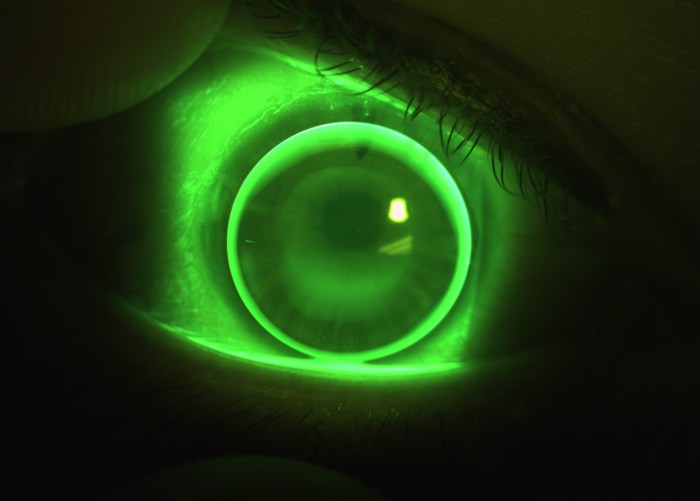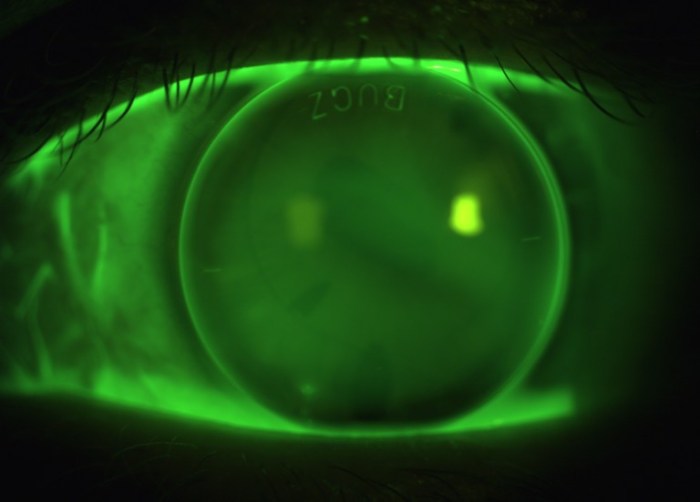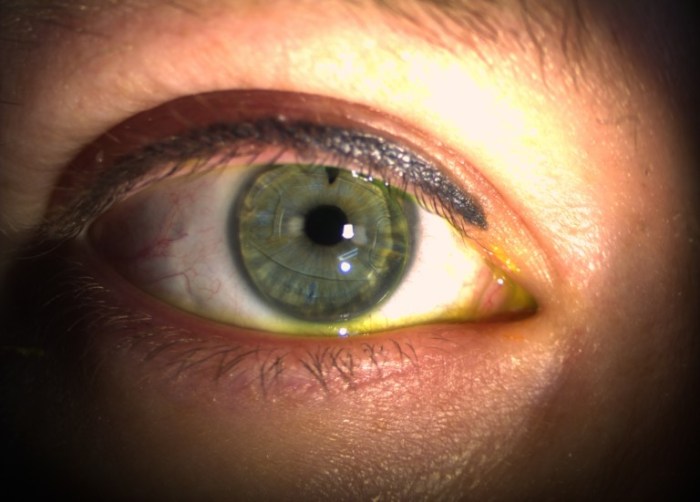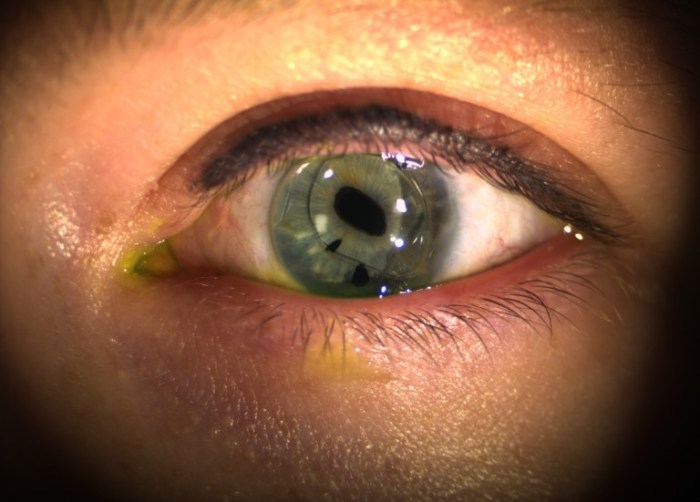When is a bitoric lens fitted? This question marks the beginning of an enlightening journey into the realm of vision correction, where we delve into the intricacies of bitoric lenses and their remarkable ability to restore clear vision to those with corneal irregularities.
Bitoric lenses, a specialized type of contact lens, are meticulously designed to address the unique challenges posed by irregular corneal surfaces. Their sophisticated construction empowers them to correct astigmatism and other corneal aberrations, offering unparalleled visual clarity and comfort.
Indications for Fitting Bitoric Lenses

Bitoric lenses are specialized contact lenses designed to correct irregular corneal surfaces or astigmatism. They are typically prescribed when conventional spherical or toric lenses cannot provide adequate vision correction.
Corneal irregularities or astigmatism that may necessitate the use of bitoric lenses include:
Keratoconus
- A progressive eye condition characterized by a cone-shaped cornea.
- Causes significant irregular astigmatism and vision distortion.
- Bitoric lenses can help stabilize the cornea and improve vision.
Post-Refractive Surgery
- Refractive surgeries such as LASIK or PRK can sometimes induce irregular astigmatism.
- Bitoric lenses can correct the residual astigmatism and enhance vision.
Corneal Scarring
- Trauma or disease can lead to corneal scarring, causing irregular astigmatism.
- Bitoric lenses can provide a smooth optical surface to correct the irregularities and improve vision.
Types of Bitoric Lenses

Bitoric lenses come in various types, each with unique characteristics and fitting options. The three main categories are rigid gas permeable (RGP), soft contact lenses, and hybrid lenses.
Rigid Gas Permeable (RGP) Bitoric Lenses
RGP bitoric lenses are made of a rigid, oxygen-permeable material. They provide excellent vision correction and are durable. However, they can be less comfortable than soft lenses and require a longer adaptation period. RGP lenses are often recommended for patients with severe astigmatism or other complex eye conditions.
Soft Bitoric Lenses
Soft bitoric lenses are made of a soft, flexible material. They are more comfortable than RGP lenses and easier to insert and remove. However, they may not provide as sharp vision as RGP lenses and can be more prone to dehydration.
Soft bitoric lenses are a good option for patients with mild to moderate astigmatism.
Hybrid Bitoric Lenses
Hybrid bitoric lenses combine the benefits of both RGP and soft lenses. They have a rigid central zone that provides sharp vision and a soft peripheral zone that enhances comfort. Hybrid lenses are often recommended for patients who need the best of both worlds.
Lens Design Considerations
The design of a bitoric lens is crucial for its performance. The base curve is the curvature of the lens that rests on the cornea. The diameter is the overall size of the lens. The toric power is the amount of astigmatism correction the lens provides.
These parameters are carefully customized to ensure a proper fit and optimal vision correction.
Fitting Process for Bitoric Lenses

Fitting bitoric lenses requires a comprehensive process to ensure optimal vision correction. This involves several key steps:
Corneal Topography, When is a bitoric lens fitted
Corneal topography is a non-invasive imaging technique that maps the curvature and shape of the cornea. This detailed map helps determine the specific shape and power of the bitoric lens needed to correct the astigmatism.
When a person has an astigmatism, a bitoric lens is fitted to correct the condition. An astigmatism is a condition in which the cornea is not perfectly round, which causes light to focus at different points on the retina. This can result in blurred vision.
Bitoric lenses are specially designed to correct this problem. They have two different curvatures, which help to focus light evenly on the retina. One of the most popular bitoric lenses is the aroma joe’s blue mermaid rush . This lens is made of a high-quality material that is comfortable to wear and provides excellent vision correction.
Bitoric lenses can be fitted by an eye doctor or an optometrist.
Refraction
Refraction measures the refractive error of the eye, including astigmatism. This is done using a phoropter or autorefractor to determine the lens power required for clear vision.
Lens Evaluation
Diagnostic lenses are used to evaluate the fit and performance of the bitoric lens. These lenses are placed on the eye to assess the lens alignment, centration, and visual acuity. Trial fitting allows the eye care professional to fine-tune the lens parameters to achieve the best possible vision.
Post-Fitting Care and Monitoring: When Is A Bitoric Lens Fitted
Maintaining proper care and monitoring of bitoric lenses is crucial for optimal performance and ocular health. This includes regular cleaning, disinfection, and storage, as well as follow-up appointments for lens evaluation and adjustments.
Cleaning and Disinfection
Bitoric lenses should be cleaned and disinfected daily to remove debris, microorganisms, and protein deposits. This helps prevent infections, discomfort, and reduced vision. Recommended cleaning methods include:
- Rubbing the lenses gently with a clean fingertip and lens cleaning solution.
- Using an automated lens cleaner.
- Rinsing the lenses thoroughly with saline solution.
After cleaning, lenses should be disinfected using a hydrogen peroxide-based or multipurpose contact lens solution. Follow the manufacturer’s instructions carefully to ensure proper disinfection.
Storage
When not in use, bitoric lenses should be stored in a clean lens case filled with fresh contact lens solution. This helps keep the lenses moist and prevents the growth of microorganisms.
Follow-up Appointments
Regular follow-up appointments are essential for assessing the fit and performance of bitoric lenses. These appointments typically involve:
- Lens evaluation to check for any changes in fit, power, or corneal health.
- Vision testing to ensure optimal visual acuity.
- Adjustments to the lens fit or prescription as needed.
Potential Complications and Signs of Improper Fit
Improperly fitted bitoric lenses can cause discomfort, reduced vision, or corneal irritation. Signs of an improper fit include:
- Pain or discomfort when wearing the lenses.
- Blurred or distorted vision.
- Redness, swelling, or irritation of the eyes.
- Corneal abrasions or ulcers.
If you experience any of these symptoms, it is important to remove the lenses and consult with your eye care professional immediately.
Benefits and Limitations of Bitoric Lenses

Bitoric lenses offer several benefits for individuals with corneal irregularities:
Improved Vision Quality
Bitoric lenses correct both the spherical and cylindrical components of refractive errors, resulting in sharper and clearer vision. They minimize corneal distortion, allowing light to focus precisely on the retina, improving visual acuity and reducing ghosting or double vision.
Reduced Corneal Distortion
Bitoric lenses are designed to conform to the irregular shape of the cornea, providing a smooth optical surface. This reduces corneal distortion and improves the overall quality of vision, particularly for individuals with conditions like keratoconus or corneal scarring.
Increased Comfort
Unlike rigid gas permeable (RGP) lenses, bitoric lenses are made of soft and flexible materials that conform to the cornea, providing a more comfortable fit. They are less likely to cause irritation or discomfort, even during extended wear.
Limitations of Bitoric Lenses
Despite their benefits, bitoric lenses also have certain limitations:
Potential Difficulties in Fitting
Fitting bitoric lenses can be more challenging than fitting standard contact lenses due to the need for precise alignment with the irregular corneal surface. This may require multiple fitting sessions and adjustments to achieve optimal vision correction.
Higher Cost
Bitoric lenses are generally more expensive than standard contact lenses due to their complex design and manufacturing process.
Reduced Availability
Bitoric lenses are not as widely available as standard contact lenses, and may not be available from all optometrists or contact lens retailers.
Comparison to Other Methods of Corneal Irregularity Correction
Bitoric lenses are not the only option for correcting corneal irregularities. Other methods include:*
-*Refractive Surgery
Surgical procedures such as LASIK or PRK can reshape the cornea to improve vision. However, these procedures are invasive and may not be suitable for all individuals.
-*Corneal Transplants
In severe cases, a corneal transplant may be necessary to replace the damaged or irregular cornea with a healthy donor cornea. This is a major surgical procedure with potential risks and complications.The choice of treatment method for corneal irregularities depends on the individual’s specific condition, preferences, and lifestyle.
Bitoric lenses offer a non-invasive and comfortable option for many individuals with mild to moderate corneal irregularities, while refractive surgery or corneal transplants may be more suitable for more severe cases.
Detailed FAQs
What are the signs that I may need a bitoric lens?
Common indicators include blurred or distorted vision, difficulty seeing at night, and frequent headaches or eye strain.
How is the fitting process for bitoric lenses different from regular contact lenses?
Bitoric lens fitting requires specialized measurements and diagnostic tools to ensure proper alignment and optimal vision correction.
Are bitoric lenses comfortable to wear?
Modern bitoric lenses are designed to provide a high level of comfort, with advanced materials and fitting techniques minimizing any potential discomfort.